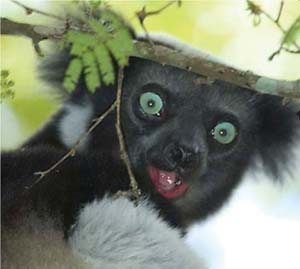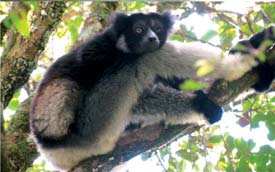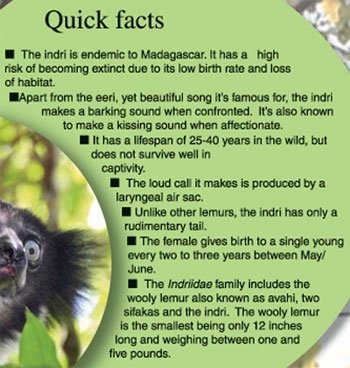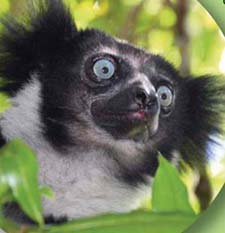Nature Trail
Indri - the largest lemur in existence

What strikes you most when you look at the creature featured here?
Perhaps, its strong resemblance to a giant panda. Well, most are of the
view that the indri which belongs to the Indriidae family (which
includes sifakas and wooly lemurs), does resemble a panda in appearance
even though it's only a lemur.
Would you believe that the indri, also known as babakoto (pronounced
baba-koot) is the largest lemur in existence along with the Diademed
Sifaka? Measuring 64-72cm from head to body and weighing upto 13kg, the
indri which is found in the northern parts of Madagascar is a primate
under threat today.
It is one of the most endangered species among the animals endemic to
Madagascar, and has a high risk of becoming extinct.
It has the appearance of a teddy bear with its bare black face,
framed by fuzzy ears, large greenish eyes and silky fur, which is mostly
black with white patches along the neck, limbs and lower back.
The body fur colour varies among different populations with some
indris having mostly black fur. It has a long neck, long
 arms and also
long muscular legs which it uses to propel from one tree to another, as
it's a tree dwelling creature. arms and also
long muscular legs which it uses to propel from one tree to another, as
it's a tree dwelling creature.
It's known to be a vertical climber and leaper, holding its body
upright when travelling through trees.

The indri is well known for its rather eeri, but beautiful song which
carries for more than two kilometres through the jungle. Its distinctive
songs which lasts for about 45 seconds to three minutes, are sung
usually in a three phase pattern. Researchers say the roar sequence
which is generally sung by all the members of the group, except the very
young, lasts for about seven seconds.
The song proper is generally dominated by the adult pair in the
group. The roar sequence is followed by a note sequence which lasts for
another five seconds and the descending phrase sequence begins. In this
part of the song, the wails start as a high note and progressively come
to a lower pitch. It is common for two or more animals to coordinate the
timing of the descending notes to form a duet.
It is said that the structure and duration of the songs could vary
among and within the groups which comprise the adult couple and the
offspring, including the maturing offspring. Indris are known to form
long term partnerships, with new mates being sought only in the event of
death of one partner.
 One of the reasons for this beautiful animal's decline is its low
birth rate. The female gives birth to a single young every two to three
years, after a gestation period of approximately 60 days. One of the reasons for this beautiful animal's decline is its low
birth rate. The female gives birth to a single young every two to three
years, after a gestation period of approximately 60 days.
Born during May/June, the young are mostly black at birth. They get
the white fur by about two or three months. The young usually travel
about, clinging to the mother's belly until they are about four or five
months.
Then they travel on the back of their mothers. By about eight months,
they are independent enough to move about on their own, but until they
are at least two years old, they are not fully independent of their
mums, the primary care-givers. The males too assist in the upbringing,
to some extent.
The indri is herbivorous, primarily folivorous, feeding on about 63
plant species in lowland and montane forests. It also feeds on fruits
and seeds.
Males are known to consume more fruits. The indri has been observed
to transfer the fruits they pick on to eat from the hand to the mouth,
while the leaves are picked off the tree, directly with its mouth.
Even though it lives mostly on the tree canopy, it occasionally
descends to the ground to eat soil. Within the group, the female in the
leading pair tends to be dominant and has priority to the food reserves.
Active during the day, the group of indri settle down in a 'sleep
tree' prior to dusk. When moving about, foraging for food, it prefers to
negotiate gaps between the tree branches by leaping. It can leap between
10 to 30 cm.

 The name indri is said to have been given to this animal following a
misunderstanding that occurred when the natives of Madagascar pointed
out the creature to a French naturalist named Pierre Sonnerat. The name indri is said to have been given to this animal following a
misunderstanding that occurred when the natives of Madagascar pointed
out the creature to a French naturalist named Pierre Sonnerat.
When the natives had used the local word meaning "there" to show the
animal it had been assumed that the animal's name was that. So, it came
to be known as indri, but in Madagascar it is also known by the names
babakoto and ambalana.
There are many myths and legends about lemurs. Most legends establish
the close relationship between lemurs and humans. Even though the legend
of its origin varies, the lemur is treated as a sacred animal. Therefore
it is revered and protected by the natives.
Many claim that the lemur has been seen sunbathing or
sun-worshipping, going by the posture it adopts during this act. It has
been observed at sunrise sitting, facing the sun on a branch with its
back upright, legs crossed, hands low with palms upturned and resting on
knees and eyes half closed.
This teddy-bear like creature which is revered in Madagascar is
highly endangered today due to habitat loss.
|

